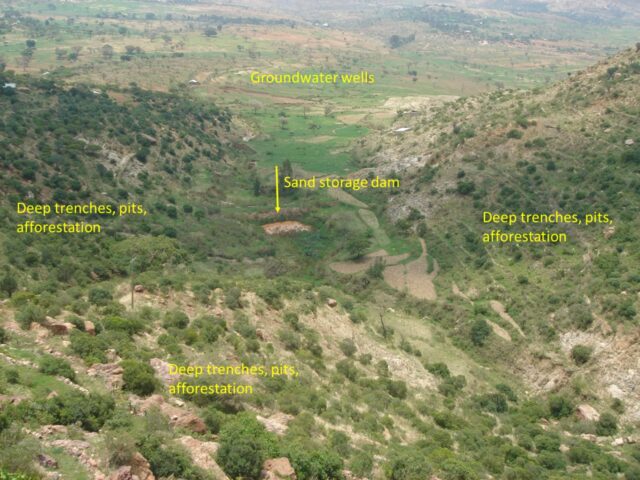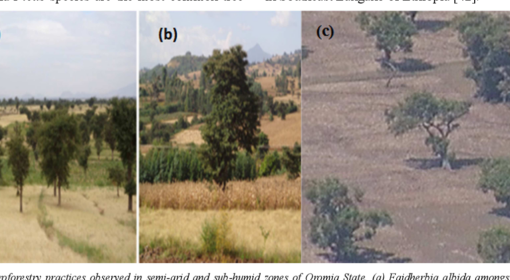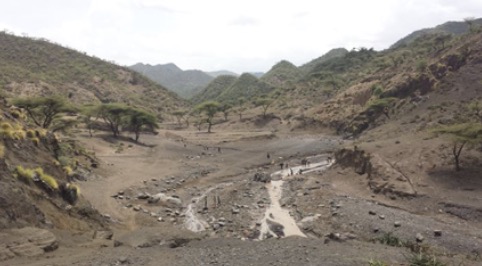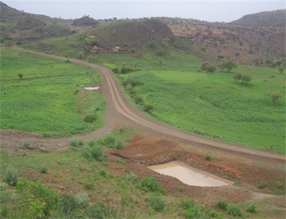by Kifle Woldearegay and Frank van Steenbergen

Mountainous regions generate floods, and these often cause huge economic, social and environmental damage. This is borne out by many countries that in recent years witnessed catastrophic floods originating from their mountain areas – Pakistan, Brazil, PNG, Afghanistan, Myanmar. These were also the places where there was little attention for catchment management and landscape restoration. Many have argued (Arfan, et al., 2020; Saleem et al. 2023) that water resources need to be harnessed from the source and regulated in the catchment to restore the hydrology and control sedimentation. In several countries such turnarounds have taken place with good results. What has been important is the deployment of many small measures, to harvest water, to regreen, to capture sediment – creating a critical mass for change. What has always been important is that this is rooted in local capacity, management and economy – that the measures are planned locally and generate immediate local benefit in addition to the effects on flood peaks, runoff, storage, baseflow.
Effects on flood peaks, runoff storages and baseflow
Integrated watershed management is about retaining water in the upper catchment and creating water buffers. Soil conservation and water harvesting measures are the most common techniques for converting excess rainwater(runoff) into soil moisture and groundwater reserve to achieve sustained base flow in the dry season (Nyssen et al., 2010; Lemann, 2016). In every geography a different mix of measures is most appropriate.
When catchment management is done right, the impact on hydrology and sedimentation is significant. Here is some evidence.
- Amini et al. (2014) studied impacts of watershed management on runoff storage and peak flow in Iran and found that peak flow decreased from 10.5 m3/s for pre-management conditions to 8 m3/s for post-management conditions. The same authors reported that: (i) for post-management condition, the runoff storage values for non-structural measures are predicted to be increased with larger increments than those for structural measures with respect to return periods, and (ii) structural measures in the watershed (using check dams to store runoff) caused a delay in flow at the outlet and reduced the channel slope whereby water stored in reservoirs of the check dams acted as a buffer to decrease the peak discharges and increase the low discharges.
- Singh et al. (2014) compared treated and untreated (control) watersheds in India and found that IWM interventions have reduced storm flow and at same time enhanced base flow from 1.2% to 4.3% of total rainfall. The same authors reported that base flow was recorded at watershed outlet and around drainage network during and after the monsoon season for a greater number of days (increased from 35 to 110 days on average) in a treated watershed compared to a control watershed.
- Tadesse et al (2015) reported on watershed in Ethiopia and found that uncontrolled runoff volume reduced up to 13% due to integrated catchment. Woldearegay et al. (2024) have reported up to 73% increase in spring discharge (due to upstream IWM) in Ethiopia. A recent report by TBoARD (2023) show that in some small catchments in Tigray, Ethiopia runoff has ceased after constructions of different soil and water conservation and water harvesting measures (e.g. Figure 1) as part of the IWM. Muhidin et al. (2024) have reported that: (a) treated watersheds have increased specific discharges by 71% in the dry period, (b) the specific discharge in the wet season was higher at the untreated than at the treated micro-catchment showing a high risk of flood and quick response to rainfall events, and (c) during the wet season, the mean specific base flow discharge at the untreated micro-catchment was 4.28 times greater than the base flow at treated micro-catchment in the first year and about 1.87 times greater in the second-year records.
Converting peak runoff into (ground)water reserves using different interventions is, therefore, a powerful approach whereby: flooding would be deceased; groundwater level in the valley bottoms would be enhanced; stream flows increased during dry season for accessing surface and groundwater reserve for domestic water supply, livestock, and irrigated agriculture.
Next to rebalancing catchment hydrology, there is also the effect on sedimentation.
Watershed management affect sediment transport and deposition to downstream areas. Here is some more evidence on the effect of integrated water management on sedimentation at catchment level.
- Singh et al (2014) compared treated and untreated (control) watersheds in India and found that: (i) interventions helped in reducing soil loss more than 50% compared to control watershed, (ii) the average annual soil loss measured from the treated watershed was 1.5 t ha-1 which was significantly lower than 5.5 t ha-1 in control watershed, and (iii) silt deposition in check dams at treated watershed was found less than 10% of their gross storage capacity while check dam at outlet of control watershed silted 70% to their gross storage capacity.
- Ethiopia: Tadesse et al (2015) studied watersheds in Ethiopia and found that sediment load reduced up to 40% due to watershed management. Woldearegay et al. (2024) reported a 65% reduction in suspended sediment in northern Ethiopia.
References:
Amini, A., Ghazvinei, P.T., Javan, M., Saghafian B. (2014). Evaluating the impacts of watershed management on runoff storage and peak flow in Gav-Darreh watershed, Kurdistan, Iran. Arab J Geosci 7, 3271–3279 (2014). https://doi.org/10.1007/s12517-013-0950-1.
Arfan, M., Ansari, K., Ullah, A., Hassan, D., Siyal, A.A., & Jia, S. (2020). Agenda Setting in Water and IWRM: Discourse Analysis of Water Policy Debate in Pakistan. Water, 12, 1656.
Brutsaert W (2005) Hydrology: An Introduction. Cambridge: Cambridge University Press, 605 pp.
Lemann, T., Gete Z., Caroline A., Luciano G., Hannes S. and Vincent R. (2016). Modelling the effect of soil and water conservation on discharge and sediment yield in the upper Blue Nile basin, Ethiopia. Applied geography, vol. 73, pp. 89-101.
Muhidin, M.S., Ayana, M., Biru, Z., Alamerew, T. & Desta, G. (2024). The Impact of Soil and Water Conservation Measures on Base Flow Modification in the Northeastern Highland of Ethiopia. Preprints.org (www.preprints.org). doi:10.20944/preprints202403.0701.v2.
Munir, B.A., & Iqbal, J. (2016). Flash Flood Water Management Practices in Dera Ghazi Khan City (Pakistan): A Remote Sensing and GIS Prospective. Nat. Hazards, 81, 1303–1321.
Nyssen, J., Clymans, W., Descheemaeker, K., Poesen, J., Vandecasteele, I., Vanmaercke, M., Zenebe, A., Camp, M., Haile, M., Haregeweyn, N., Moeyersons, J., Martens, K., Gebreyohannes, T., Deckers, J. and Walraevens, K. (2010). Impact of soil and water conservation measures on catchment hydrological response-a case in north Ethiopia. Hydrological Processes, pp. 1-35.
Saleem, M., Arfan, M., Ansari, K., & Hassan, D. (2023). Analyzing the Impact of Ungauged Hill Torrents on the Riverine Floods of the River Indus: A Case Study of Koh E Suleiman Mountains in the DG Khan and Rajanpur Districts of Pakistan. Resources, 12, 26. https:// doi.org/10.3390/resources12020026.
Singh, R., Garg, K.K, Wani, S.P., Tewari, R.K, Dhyani, S.K. (2014). Impact of water management interventions on hydrology and ecosystem services in Garhkundar-Dabar watershed of Bundelkhand region, Central India. Journal of Hydrology 509: 132–149. https://doi.org/10.1016/j.jhydrol.2013.11.030.
Tadesse, A., Dagnew, D.C., Belete, M.A., Tilahun, S.A., Mekuria, W., & Steenhuis, T. (2015). Impact of soil and water conservation practices on sediment losses and discharge in the headwaters of the Lake Tana Basin in the Ethiopian highlands. Abstract: AvH10-42-1. 10th Alexander von Humboldt International Conference, 18– 20 November, Addis Ababa, Ethiopia.
Wang, G., Mang, S., Cai, H., Liu, S., Zhang, Z., Wang, L., Innes, J., (2016). Integratedwatershed management: evolution, development and emerging trends. J. For. Res. 27 (5), 967–994. https://doi.org/10.1007/s11676-016-0293-3.
Woldearegay, K., Tamene, L., Mekonnen, K., Kizito, F., Bossio, D. (2018). Fostering Food Security and Climate Resilience Through Integrated Landscape Restoration Practices and Rainwater Harvesting/Management in Arid and Semi-arid Areas of Ethiopia. In: Leal Filho, W., de Trincheria Gomez, J. (eds) Rainwater-Smart Agriculture in Arid and Semi-Arid Areas. Springer, Cham. https://doi.org/10.1007/978-3-319-66239-8_3.
Woldearegay, K., Grum, B., Hessel, R., van Steenbergen, F., Fleskens, L., Yazew, E., Tamene, L., Mekonnen, K., Reda, T., Haftu, M. (2024). Watershed management, groundwater recharge and drought resilience: An integrated approach to adapt to rainfall variability in northern Ethiopia. International Soil and Water Conservation Research, 12 (3), 663-683, https://doi.org/10.1016/j.iswcr.2023.08.009.
TBoARD (Tigray Bureau of Agriculture and Rural Development) (2023). Annual report of the Tigray Bureau of Agriculture and Rural Development for 2022. Mekelle, Tigray, Ethiopia. 25 pp.



